What does blood red hawthorn look like and how to grow it?

Many people know what a blood red hawthorn looks like, but not everyone knows how to grow it properly. This plant is rightly considered a real storehouse of vitamins for hibernating birds and humans. These shrubs, unique in all respects, have long settled in many summer cottages. The main advantages of all types of hawthorn can be safely attributed to abundant fruiting, unpretentiousness and ease of care, since the plant is able to survive and develop even in its complete absence.

general description
The hawthorn blood-red or Siberian is a representative of the Rosaceae family with the corresponding characteristics, life form and flower formula (* Ч5Л5Т∞Т (4)). It can be found almost throughout the entire territory of the Russian Federation. This plant is a shrub that, under certain conditions, can grow up to 7 meters in height.
In nature, there are also relatively small (up to 4 meters) specimens.
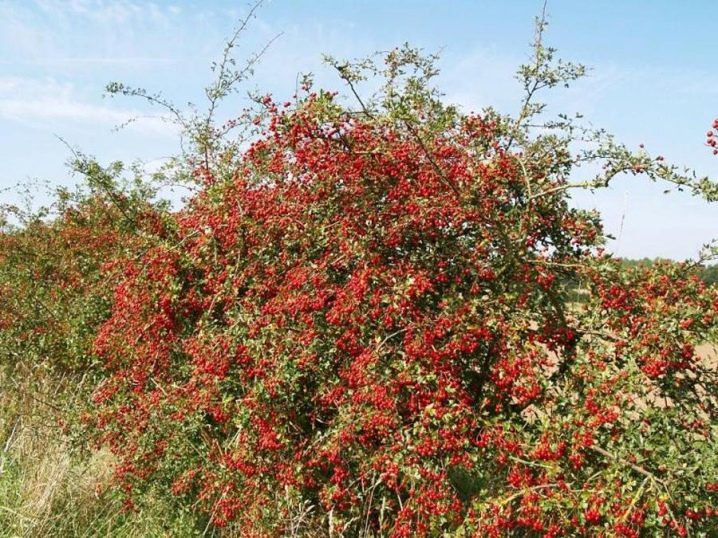
Studying the historical facts concerning the homeland of the hawthorn, it is worth noting that the first mentions of it date back to the era of Ancient Greece. At the moment, in Russia, the length of the plant habitat zone is more than 5 thousand km, and it itself includes:
- Western and Eastern Siberia;
- Transbaikalia;
- eastern regions of the European part.
In addition, the considered bushes live in the territories of Mongolia, China, Central Asia and Kazakhstan. According to the botanical description, the hawthorn is a plant with shoots literally covered with sharp thorns 2 to 5 cm long.
The leaves, which are located alternately, have a pinnate shape. Stipules are of two types: sickle-shaped and coco-heart-shaped.

Rather large inflorescences in hawthorns are formed from small white flowers with purple anthers. Abundant flowering starts in May, and only by the end of the summer period fruits ripen in the form of balls with a diameter of up to a centimeter. Both at the stage of flowering and at the time of fruiting, the bushes look very beautiful. It is with this feature in mind that hawthorn is widely used today as a decorative element in the design of garden, summer cottage and backyard plots.

Most often, there are bushes on the plots, the average height of which is 5 meters. They are quite thorny and at the same time adapted to live in almost any conditions. Particularly noteworthy are the fruits of the described representative of the Rosaceae family, and we are talking about spherical or ellipsoidal berries, which are called apples. Their color can be both bright red and burgundy, and even orange. The seeds are located in the mealy pulp of the fruit. Most often, the latter have a neutral taste, but some artificially bred varieties can bear fruit with sweetish berries.

Landing
The key is choosing the right place for the bushes. In this case, it is important to consider how much the plant loves sunlight.
It is important to remember that a lack of lighting can adversely affect flowering and fruiting, and also exclude these two stages of hawthorn development altogether.

Another feature that is important when planting plants is that they have a developed root system. In the overwhelming majority of cases, it goes deep underground, which is why the bushes do not respond well to transplantation. That is why such agrotechnical procedures are relevant until the plant has reached 5 years of age.
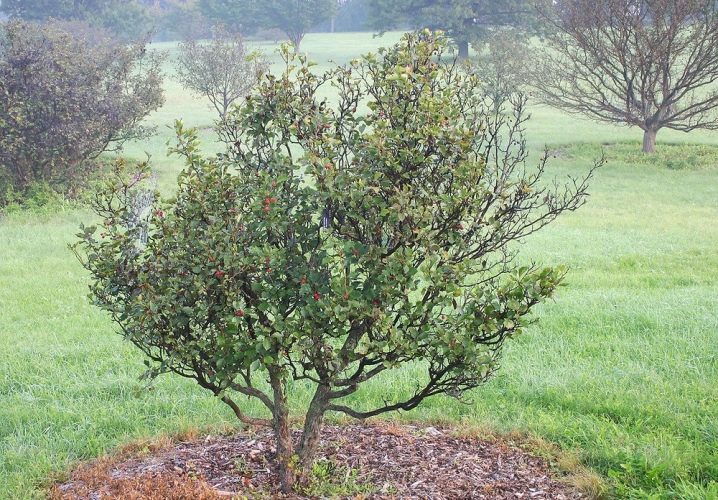
It is noteworthy that heavy soils are quite suitable for the blood-red hawthorn variety. It is important that the soil is fertile. Given these nuances, it is strongly recommended to pay appropriate attention to soil preparation before planting. The algorithm itself looks like this:
- preparation of pits (holes), the depth of which reaches 0.9 meters;
- at the bottom of each planting pit, a drainage layer about 15 cm thick is formed from small stones, broken bricks, coarse river sand;
- filling over the drainage of a thin layer (up to 1 cm) of lime;
- preparation of the substrate by thoroughly mixing river sand, humus, as well as peat and soil taken from under deciduous trees;
- filling 2/3 of the holes with the resulting mixture;
- placement of seedlings in the holes (it is important to carefully and evenly spread the roots).

At the next stage, the bushes are lightly sprinkled with soil mixture and watered abundantly. After that, the pits are filled with soil to the end, trampled down and mulched.
When planting the described bushes, it is important to take into account that the seedlings are located at a depth of about 0.7 m, and the root collar should be at the level of the soil edge. Young animals can be placed in permanent habitat at the age of 2 to 5 years. It is precisely such an age range that is considered optimal due to the fact that during this period the root system already reaches a certain level of development, but at the same time it is young and strong enough to withstand changes in growing conditions without much stress.
Planting is best done in the spring or early autumn.

The next important point is the spacing between seedlings. Here, the purpose of the planted bushes will play a key role. So, if we are talking about creating a living fence, then the interval should be 0.2 m. In situations where the shape of the crown, flowering and an abundance of fruits will be at the forefront, the distance between the plants is 2 meters or more.

Care
When growing blood-red hawthorn, it is necessary to pay attention not only to the correct choice of place, taking into account the plant's attitude to light, but also to further care for the bushes. This refers to such agrotechnical measures as:
- regular watering;
- timely and competent feeding;
- weeding;
- trimming and trimming;
- performing various procedures for preventive purposes.
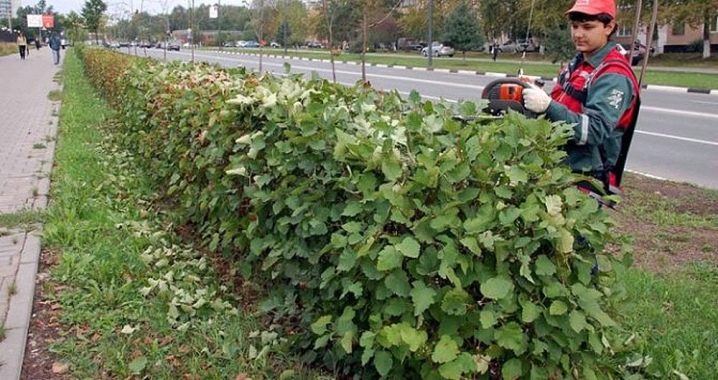
During the growing season, it is recommended to pay special attention to thorough weed harvesting. It is necessary to get rid of these undesirable neighbors in a timely manner, which, taking into account the characteristics of the season, actively appear around the bushes. In parallel, it is required to loosen the soil regularly (after each irrigation) and, if necessary, renew the mulch layer. With the arrival of autumn, the root zone must be dug to a depth of about 20 cm.
Compliance with the basic rules of care guarantees the presence of healthy and strong hawthorn bushes with outstanding decorative qualities on the site. By the way, they, with appropriate maintenance, may well perform the functions of a hedge.

Watering and feeding
For full development, flowering and fruiting, the hawthorn requires a sufficient amount of moisture. The standard irrigation regime is monthly irrigation at the rate of 10 liters of water for each plant. However, in hot summer, the frequency of such procedures predictably changes, so the bushes are watered up to 3 times a month.
An equally important point is the timely and correct application of fertilizers. As practice shows, without such agricultural practices, it will not be possible to create the most favorable conditions for the blood-red hawthorn.

Nutrient soil is the key to active growth and full development.However, it is inevitably depleted with prolonged growth of bushes in one place.
Experienced gardeners know that the main and most suitable fertilizer for the described plant is cow dung. And this top dressing is prepared in advance by soaking the main component in water in a 1: 2 ratio. The solution is infused for 14 days. Spread the product around the bushes in early spring.

In addition to the specified organic matter, it is recommended to feed the hawthorn with nitrophosphate and humates. These substances must be added:
- before budding;
- before the beginning of the flowering period;
- after the bush has faded.
It should be remembered that regardless of the purpose of the grown bushes, it is important to provide the necessary soil nutrition. As a result, the bushes will delight the owner of the site with a rich and aesthetic crown, as well as abundant flowering and a high-quality harvest of berries.
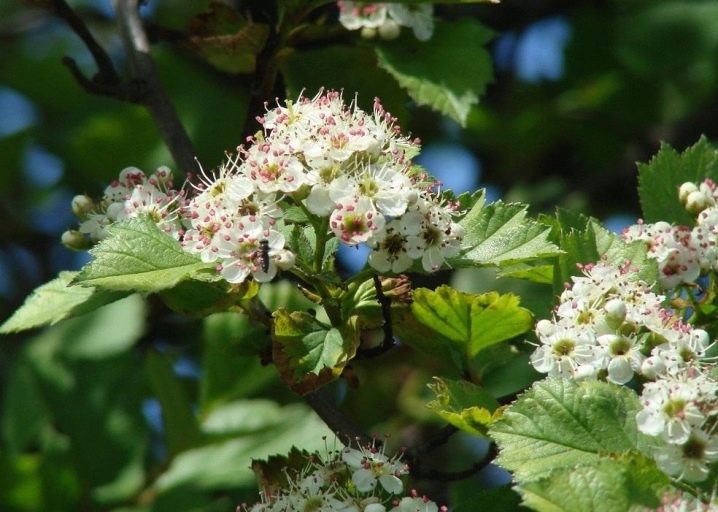
Pruning
It is important to remember that the key points of care are formative treatment of the bushes, as well as sanitary pruning. In the second case, we are talking about the timely removal of dry and damaged shoots.
The best time for such agrotechnical events is spring.
Annual pruning can significantly improve the decorative qualities of the hawthorn. Modern gardeners easily give the bushes square, spherical and pyramidal shapes. Naturally, you should also remember about keeping in shape through a haircut.

Wintering
In this case, it is worth focusing on the fact that young plants require more care, and this is especially important for preparing bushes for the winter period. Up to 5 years of age, you will need to cover the branches and root system with burlap and peat or dry leaves. This approach allows you to provide the most effective protection and prevent freezing. Adults do not need such measures, since they have sufficient resources to overcome the winter frosts.

Reproduction
Today, there are and are practicing several methods of breeding the described shrubs and trees. And we are talking about the following breeding options:
- from seeds;
- using layering;
- root suckers;
- cuttings (green and root cuttings);
- stock (grafting).
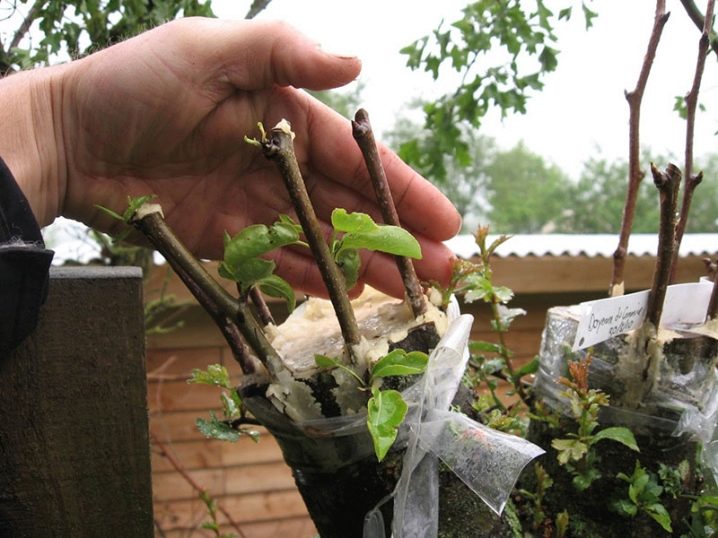
According to current statistics, the first method on the list is rarely used by modern gardeners. It is much more common to breed hawthorn by layering. The main thing is to have a healthy and strong mother bush. On it, one of the lower shoots is selected, bent to the ground and buried in it. Quickly enough, these layers take root, and a sprout breaks through to the surface.
It is quite simple in implementation and method of use for propagation of root suckers.
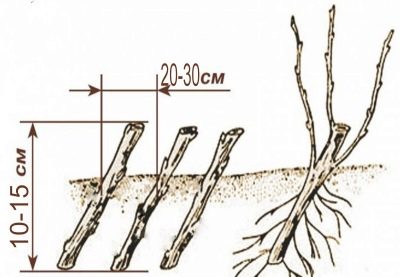
Here, the main task is to dig out the shoots from an adult and transplant it. In addition, root cuttings are often used. To implement this method you will need:
- dig up the rhizome in the fall;
- completely clean it from soil and roots;
- cut 10 cm cuttings;
- plant the resulting material at an angle of 45 degrees to a depth of 2 cm;
- cover the landing with foil.
It is important that the cuttings root in moist soil. It will be possible to transfer seedlings to a permanent place in the spring. The stock is propagated mainly by hybrid varieties, which allows to preserve all the characteristics of the mother bush to the maximum.

Diseases and pests
One of the important components of hawthorn care is to protect the plant from pest attacks. The greatest danger to the bushes is represented by:
- hawthorn butterfly;
- goldtail;
- ringed silkworm.
It is worth noting that this trio of harmful insects also damages apple and pear trees. Taking this fact into account, experienced gardeners process hawthorn along with fruit plantings in the spring for prevention purposes.
At the same time, "Fufanon" and other drugs with a similar effect are successfully used.

In situations where caterpillars have time to appear, a unique plant delphinium will come to the rescue. To prepare the infusion, you will need to grind 1 kg of leaves and stems of this flower and pour the resulting mass with 10 liters of water. The solution is insisted for 3 days, after which the bushes that have been attacked by pests are filtered and sprayed with it. During the swelling and opening of the buds, the hawthorn can be attacked by copperheads and aphids. In this case, treatment of plants with "Aktara" and "Decis" will be an effective means of control.

If we assess the level of potential danger in the context of fungal diseases, then special attention should be paid to such troubles as powdery mildew. In infected bushes and trees, foliage, shoots and even inflorescences are covered with a characteristic bloom. The next stage is yellowing, deformation and falling of leaves, slowing down the growth of shoots and drying out the tops. As a preventive measure, spring spraying with Bordeaux liquid is successfully used.

Application in landscape design
The described type of hawthorn belongs to ornamental plants. These bushes and trees look aesthetically pleasing throughout the season. In the spring, they are literally covered with white flowers, and closer to autumn they acquire a blood-red color thanks to the fruits. Hawthorn is no less attractive during leaf fall.

Since ancient times, these plants have been successfully used as hedges. A dense crown, dense foliage and, of course, sharp thorns act as a reliable, but at the same time aesthetic barrier. In addition, such bushes go well with other ornamental plants (linden, chestnut, maple) as part of landscape compositions.




































































The comment was sent successfully.